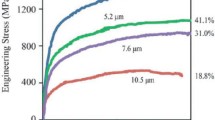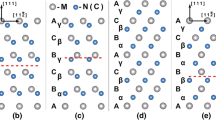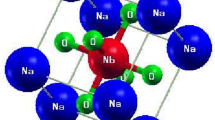Abstract
Upon reviewing the correlation between the electronic structure and the elastic properties of nanolaminates based on the previously published ab-initio data, the authors suggest that nanolaminates can be described as interleaved layers of high and low electron density. Mn+1AXn phases (space group P63/mmc) can be characterized by stacking of layers of high (MX) and low (A) electron density. Furthermore, the Mn+1AXn phases possess the bulk-modulus-to-C44 ratio of 1.2–1.7, which in turn gives rise to a combination of ceramic and metallic properties. This design criterion is not only limited to the Mn+1AXn phases, but it can be found in many other phases crystallizing in the same space group (ternary phosphides, Al3BC3, Zr2Al3C5, and W2B5 based phases) and the related space group P6/mmm (Yn+1Co3n+5B2n) as well as in the phases of the cubic \( Pm\overline 3 m \) symmetry (perovskite borides and nitrides).
Similar content being viewed by others
References
D. Music, Z. Sun, and J.M. Schneider, “Alternating Covalent-Ionic and Metallic Bonding in Perovskite Borides Studied Using Ab Initio Methods,” Phys. Rev. B, 71(5) (2005), p. 052104.
M.W. Barsoum, “The MAX Phases: A New Class of Solids; Thermodynamically Stable Nanolaminates,” Prog. Solid State Chem., 28(1–4) (2000), pp. 201–281.
M.W. Barsoum and T. El-Raghy, “The MAX Phases: Unique New Carbide and Nitride Materials,” Amer. Sci., 89(4) (2001), pp. 334–343.
H. Nowotny, “Strukturchemie Einiger Übergangsmetalle Mit Den Elementen C, Si, Ge, Sn,” Prog. Solid State Chem., 2 (1970), pp. 27–70.
M.W. Barsoum and T. El-Raghy, “Synthesis and Characterization of a Remarkable Ceramic: Ti3SiC2,” J. Amer. Cer. Soc., 79(7) (1996), pp. 1953–1956.
M.W. Barsoum, T. El-Raghy, and L.U.J.T. Ogbuji, “Oxidation of Ti3SiC2 in Air,” J. Electrochem. Soc., 144(7) (1997), pp. 2508–2516.
T. El-Raghy et al., “Processing and Mechanical Properties of Ti3SiC2: II, Effect of Grain Size and Deformation Temperature,” J. Amer. Cer. Soc., 82(10) (1999), pp. 2855–2860.
Z. Sun, Y. Zhou, and M. Li, “Oxidation Behaviour of Ti3SiC2-Based Ceramic at 900–1300°C in Air,” Corro. Sci., 43(6) (2001), pp. 1095–1109.
3-One-2 LLC, Voorhees, NJ, www.3one2.com.
Kanthal, an affiliate of Sandvic AB, Sandviken, Sweden, www.kanthal.com.
P. Hohenberg and W. Kohn, “Inhomogeneous Electron Gas,” Phys. Rev., 136(3B) (1964), pp. B864–B871.
G. Kresse and J. Hafner, “Ab Initio Molecular Dynamics for Open-Shell Transition Metals,” Phys. Rev. B, 48(17) (1993), pp. 13115–13118.
G. Kresse and J. Hafner, “Ab Initio Molecular-Dynamics Simulation of the Liquid-Metal-Amorphous-Semiconductor Transition in Germanium,” Phys. Rev. B, 49(20) (1994), pp. 14251–14269.
G. Kresse and Joubert, “From Ultrasoft Pseudopotentials to the Projector Augmented Wave Method,” Phys. Rev. B, 59(3) (1999), pp. 1758–1775.
J.P. Perdew et al., “Atoms, Molecules, Solids, and Surfaces: Application of the Generalized Gradient Approximation for Exchange and Correlation,” Phys. Rev. B, 46(11) (1992), pp. 6671–6687.
P. Blaha et al., “Full-Potential, Linearized Augmented Plane-Wave Programs for Crystalline Systems,” Comput. Phys. Commun., 59(2), (1990), pp. 399–415.
H.J. Monkhorst and J.D. Pack, “Special Points for Brillouin-Zone Integrations,” Phys. Rev. B, 13(12) (1976), pp. 5188–5192.
F. Birch, J. Geophys. Res., 83(NB3) (1978), pp. 1257–1268.
L. Fast et al., “Elastic Constants of Hexagonal Transition Metals: Theory,” Phys. Rev. B, 51(24) (1995), pp. 17431–17438.
A.Y. Liu and D.J. Singh, “Elastic Instability of BCC Cobalt,” Phys. Rev. B, 47(14) (1993), pp. 8515–8519.
J.J. Nickl, K.K. Schweitzer, and P. Luxenberg, “Gas-Phase Deposit in Ti-Si-C System,” J. Less Common Metals, 26(3) (1972), p. 283.
T. Goto and T. Hirai, “Chemically Vapor Deposited Ti3SiC2,” Mat. Res. Bull., 22(9) (1987), pp. 1195–1201.
J.-P. Palmquist et al., “Magnetron Sputtered Epitaxial Single-Phase Ti3SiC2 Thin Films,” Appl. Phys. Lett., 81(5) (2002), pp. 835–837.
H. Högberg et al., “Growth and Characterization of MAX-Phase Thin Films,” Surf. Coat. Technol., 193(1–3) (2005), pp. 6–10.
C. Walter, et al., “Towards Large Area Deposition of Cr2AIC on Steel,” Thin Solid Films, 515(2) (2006), pp. 389–393.
J.-P. Palmquist et al., “Mn+1AXn Phases in the Ti-Si-C System Studied by Thin-Film Synthesis and Ab Initio Calculations,” Phys. Rev. B, 70(16) (2004), p. 165401.
J.M. Schneider et al., “Ab Initio Calculations and Experimental Determination of the Structure of Cr2AlC,” Solid State Commun., 130(7), (2004), pp. 445–449.
J.M. Schneider, R. Mertens, and D. Music, “Structure of V2AlC Studied by Theory and Experiment,” J. Appl. Phys., 99(1) (2006), p. 013501.
T. Joelsson et al., “Single-Crystal Ti2AlN Thin Films,” Appl. Phys. Lett., 86(11) (2005), p. 111913.
C. Walter et al., “Towards Large Area MAX Phase Coatings on Steel,” Steel Res. Int., 76(2/3) (2005), pp. 225–228.
J. Emmerlich et al., “Growth of Ti3SiC2 Thin Films by Elemental Target Magnetron Sputtering,” J. Appl. Phys., 96(9) (2004), pp. 4817–4826.
M. Beckers et al., “Microstructure and Nonbasal-Plane Growth of Epitaxial Ti2AlN Thin Films,” J. Appl. Phys., 99(3) (2006), p. 034902.
R. Mertens et al., “Effect of the Composition on the Structure of Cr-Al-C Investigated by Combinatorial Thin Film Synthesis and Ab Initio Calculations,” Adv. Eng. Mater., 6(11) (2004), pp. 903–907.
O. Wilhelmsson et al., “Deposition of Ti2AlC and Ti3AlC2 Epitaxial Films by Magnetron Sputtering,” Appl. Phys. Lett., 85(6) (2004), p. 1066.
H. Högberg et al., “Epitaxial Ti2GeC, Ti3GeC2, and Ti4GeC3 MAX-Phase Thin Films Grown by Magnetron Sputtering,” J. Mater. Res., 20(4) (2004), pp. 779–782.
O. Wilhelmsson et al., “Deposition and Characterization of Ternary Thin Films within the Ti-Al-C System by DC Magnetron Sputtering,” J. Cryst. Growth, 291(1) (2006), pp. 290–300.
M. Beckers et al., “Phase Stability of Epitaxially Grown Ti2AlN Thin Films,” Appl. Phys. Lett., 89(7) (2006), 074101.
R. Ahuja et al, “Electronic Structure of Ti3SiC2,” Appl. Phys. Lett., 76(16) (2000), pp. 2226–2228.
B. Holm, R. Ahuja, and B. Johannson, “Ab Initio Calculations of the Mechanical Properties of Ti3SiC2,” Appl. Phys. Lett., 79(10) (2001), pp. 1450–1452.
B. Holm et al., “Theory of the Ternary Layered System Ti-Al-N,” Appl. Phys. Lett., 91(12) (2002), pp. 9874–9877.
Z. Sun et al., “Structure and Bulk Modulus of M2AlC (M = Ti, V and Cr),” Appl. Phys. Lett., 83(5) (2003), pp. 899–901.
Z. Sun et al., “Calculated Elastic Properties of M2AlC (M=Ti, V, Cr, Nb and Ta),” Solid State Commun., 129(9) (2004), pp. 589–592.
Z. Sun et al., “Bonding and Classification of Nanolayered Ternary Carbides,” Phys. Rev. B, 70(9) (2004), p. 092102.
Z. Sun et al., “Theoretical Investigation of the Bonding and Elastic Properties of Nanolayered Ternary Nitrides,” Phys. Rev. B, 71(19) (2005), p. 193402.
D. Music, Z. Sun, and J.M. Schneider, “Electronic Structure of Sc2AC (A = Al, Ga, In, Tl),” Solid State Commun., 133(6) (2005), pp. 381–383.
D. Music, Z. Sun, and J.M. Schneider, “Ab Initio Study of Nb2SC and Nb2S2C: Differences in Coupling between the S and Nb-C Layers,” Solid State Commun., 137(6) (2006), pp. 306–309.
D. Music et al., “Coupling in Nanolaminated Ternary Carbides Studied by Theoretical Means: The Influence of Electronic Potential Approximations,” Phys. Rev. B, 73(13) (2006), p. 134117.
J.-Y. Wang and Y.-C. Zhou, “Polymorphism of Ti3SiC2 Ceramic: First-Principles Investigations,” Phys. Rev. B, 69(14) (2004), p. 144108.
J. Wang and Y. Zhou, “Dependence of Elastic Stiffness on Electronic Band Structure of Nanolaminated M2AlC (M=Ti, V, Nb, and Cr) Ceramics,” Phys. Rev. B, 69(21) (2004), p. 214111.
G. Hug and E. Fries, “Full-Potential Electronic Structure of Ti2AlC and Ti2AlN,” Phys. Rev. B, 65(11) (2002), p. 113104.
G. Hug, M. Jaouen, and M.W. Barsoum, “X-Ray Absorption Spectroscopy, EELS, and Full-Potential Augmented Plane Wave Study of the Electronic Structure of Ti2AlC, Ti2AlN, Nb2AlC, and (Ti0.5Nb0.5)2AlC,” Phys. Rev. B, 71(2) (2005), p. 024105.
J.A. Warner et al., “Ab Initio Calculations for Properties of MAX Phases Ti2TlC, Zr2TlC, and Hf2TlC,” Appl. Phys. Lett., 88(10) (2006), p. 101911.
D. Music, Z. Sun, and J.M. Schneider, “Structure and Bonding of M2SbP (M = Ti, Zr, Hf),” Phys. Rev. B, 71(9) (2005), p. 092102.
J. Wang et al., “First-Principles Prediction of Low Shear-Strain Resistance of Al3BC3: A Metal Borocarbide Containing Short Linear BC2 Units,” Appl. Phys. Lett., 89(2) (2006), p. 021917.
J. Wang et al., “First-Principles Investigation on Chemical Bonding and Bulk Modulus of the Ternary Carbide Zr2Al3C5,” Phys. Rev. B, 72(5) (2005), p. 052102.
D. Music and J.M. Schneider, “Electronic Structure and Elastic Properties of Yn+1Co3n+5B2n (n = 1, 2, 3, ∞),” J. Phys.: Condens. Matter, 18(16) (2006), pp. 4071–4076.
D. Music and J.M. Schneider, “Influence of Valence Electron Concentration on Elastic Properties of RRh3B (R=Y, Zr, and Nb),” Appl. Phys. Lett., 89(12) (2006), p. 121914.
D. Music and J.M. Schneider, “Elastic Properties of MFe3N (M = Ni, Pd, Pt) Studied by Ab Initio Calculations,” Appl. Phys. Lett., 88(3) (2006), p. 031914.
D.M. Teter, “Computational Alchemy: The Search for New Superhard Materials,” MRS Bull., 23(1) (1998), pp. 22–27.
L. Vitos, P.A. Korzhavyi, and B. Johansson, “Stainless Steel Optimization from Quantum Mechanical Calculations,” Nat. Mater., 2(1) (2002), pp. 25–28.
C. Kittel, Introduction to Solid State Physics (New York: John Wiley and Sons, 1996), pp. 59, 91, 92.
Z. Sun et al., “Ab Initio Study of M2AlN (M = Ti,V,Cr),” J. Phys.: Condens. Matter, 17(2) (2005), pp. L15–L19.
C.M. Fang et al., “General Trend of the Mechanical Properties of the Ternary Carbides M3SiC2 (M=Transition Metal),” Phys. Rev. B, 74(5) (2006), p. 054106.
Z. Sun et al., “Electronic Origin of Shearing in M2AC (M=Ti, V, Cr, A=Al, Ga),” J. Phys.: Condens. Matter, 17(46) (2005), pp. 7169–7176.
D. Music et al., “Ab Initio Study of Basal Slip in Nb2AlC,” J. Phys.: Condens. Matter, 18(17) (2006), pp. 4389–4395.
D. Music et al., “Electronic Structure and Shearing in Nanolaminated Ternary Carbides,” Solid State Commun., 139(4) (2006), pp. 139–143.
T. Liao, J. Wang, and Y. Zhou, “Deformation Modes and Ideal Strengths of Ternary Layered Ti2AlC and Ti2AlN from First-Principles Calculations,” Phys. Rev. B, 73(21) (2006), p. 214109.
H. Boller, “Gemischite Pnictide Mit Geordnetem TiP-Typ,” Monatsh. Chem., 104(1) (1973), pp. 166–171.
H. Hillebrecht and F.D. Meyer, “Synthesis, Structure, and Vibrational Spectra of Al3BC3, a Carbidecarboborate of Aluminum with Linear (C=B=C)(5-) Anions,” Angew. Chem. Int. Ed. Engl., 35(21) (1996), pp. 2499–2500.
C. Jardin et al., “First-Principles Study of Ternary Metal Borocarbide Compounds Containing Finite Linear BC2 Units,” J. Solid State Chem., 176(2) (2003), pp. 609–614.
V.M. Mathew, C.S. Menon, and K.P. Jayachandran, “Third-Order Elastic Constants and Pressure Derivatives of the Second-Order Elastic Constants of Hexagonal Boron Nitride,” J. Mater. Sci., 37(24) (2002), pp. 5237–5240.
C.S.G. Cousins and M.I. Heggie, “Elasticity of Carbon Allotropes. III. Hexagonal Graphite: Review of Data, Previous Calculations, and a Fit to a Modified Anharmonic Keating Model,” Phys. Rev. B, 67(2) (2003), p. 024109.
A. Pohl, R. Telle, and G. Petzow, “Growth Behaviour and Subgrain Structure of W2B5,” Z. Metallkd., 86(2) (1995), pp. 148–151.
R. Telle et al., “Boride-Based Nano-Laminates with MAX-Phase-Like Behaviour,” J. Solid State Chem., 179(9) (2006), pp. 2850–2857.
C. Chacon and O. Isnard, “The Structural and Magnetic Properties of Yn+1Co3n+5B2n Compounds Investigated by Neutron Diffraction,” J. Phys.: Condens. Matter, 13(25) (2001), pp. 5841–5851.
Z. Arnold et al., “Pressure Induced Changes of Magnetic Phase Transitions in RCo4B Compounds,” J. Magn. Magn. Mater., 262(3) (2003), pp. 382–388.
F. Givord et al., “The Cerium Magnetic Form Factor and Diffuse Polarization in CeRh3B2 as Functions of Temperature,” J. Phys.: Condens. Matter, 16(8) (2004), pp. 1211–1230.
M. Dubman et al., “Magnetic Ordering and Spin-Reorientation Transitions in TbCo3B2,” Phys. Rev. B, 72(2) (2005), p. 024446.
P. Rogl and L. Delong, “New Ternary Transition Metal Borides Containing Uranium and Rare Earth Elements,” J. Less-Common Met., 91(1) (1983), pp. 97–106.
R.E. Schaak et al., “Formation of Transition Metal Boride and Carbide Perovskites Related to Superconducting MgCNi3,” J. Solid State Chem., 177(4–5) (2004), pp. 1244–1251.
H. Takei et al., “Magnetic and Superconducting Properties of the Cubic Perovskite YRh3B,” J. Less-Common Met., 125 (1986), pp. 233–237.
T. He et al., “Superconductivity in the Non-Oxide Perovskite MgCNi3,” Nature, 411(6833) (2001), pp. 54–56.
D. Music, R. Ahuja, and J.M. Schneider, “Electronic Structure and Lattice Dynamics of CaPd3B Studied by First-Principles Methods,” Phys. Lett. A, 356(3) (2006), pp. 251–254.
S. Mollah, “The Physics of the Non-Oxide Perovskite Superconductor MgCNi3,” J. Phys.: Condens. Matter., 16(43) (2004), pp. R1237–R1276.
T. Shishido et al., “Solid Solution Range of Boron, Microhardness and Oxidation Resistance of the Peroviskite Type ReRh3Bx (Re=Gd, Y, Sc) Compounds,” J. Alloy Comp., 291(1–2) (1999), pp. 52–56.
J. von Appen and R. Dronskowski, “Predicting New Ferromagnetic Nitrides from Electronic Structure Theory: IrFe3N and RhFe3N,” Angew. Chem. Int., 44(8) (2005), pp. 1205–1210.
H.H. Stadelmaier and A.C. Franker, “Nitrides of Iron with Nickel, Palladium, and Platinum,” Trans. Metall. Soc. AIME, 218(3) (1960), pp. 571–572.
Author information
Authors and Affiliations
Rights and permissions
About this article
Cite this article
Music, D., Schneider, J.M. The correlation between the electronic structure and elastic properties of nanolaminates. JOM 59, 60–64 (2007). https://doi.org/10.1007/s11837-007-0091-7
Published:
Issue Date:
DOI: https://doi.org/10.1007/s11837-007-0091-7




